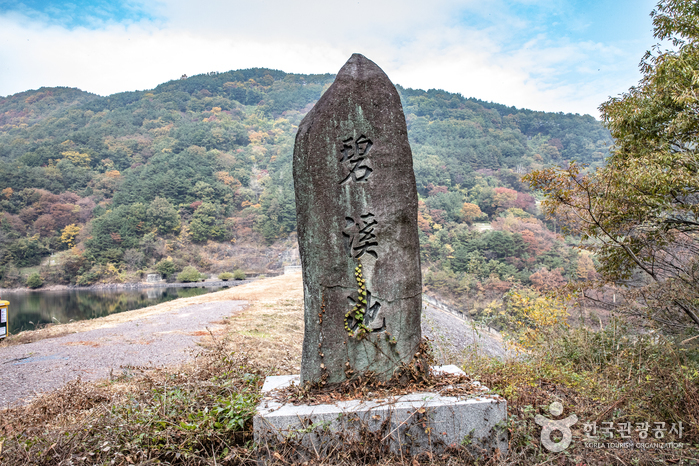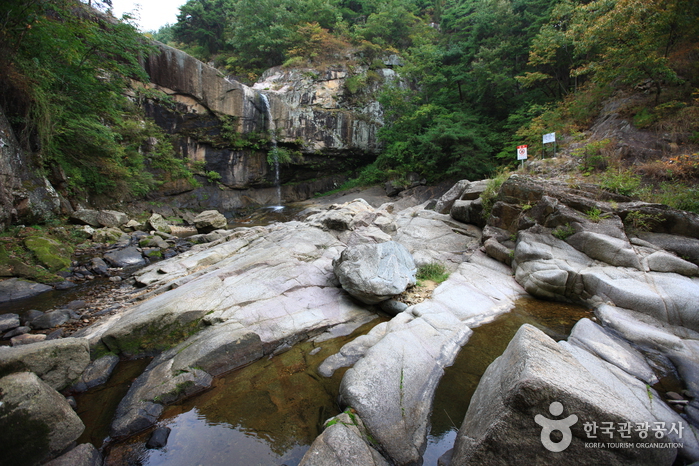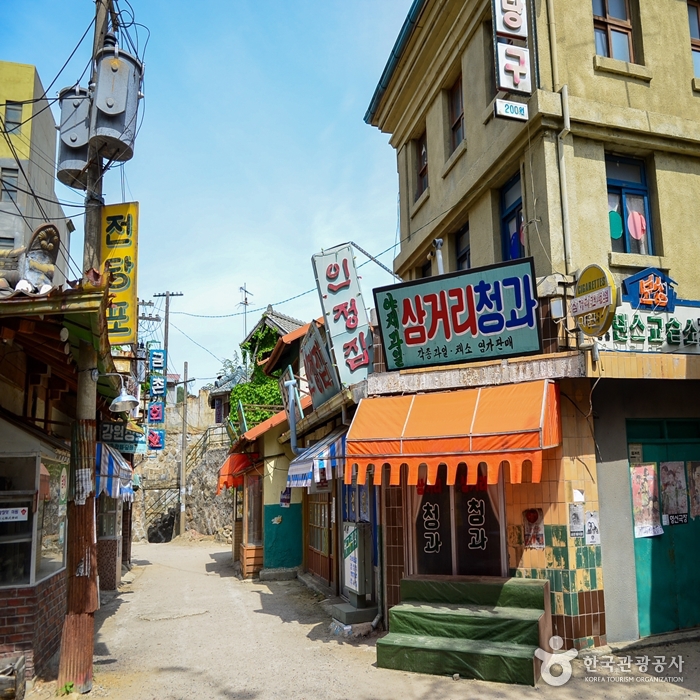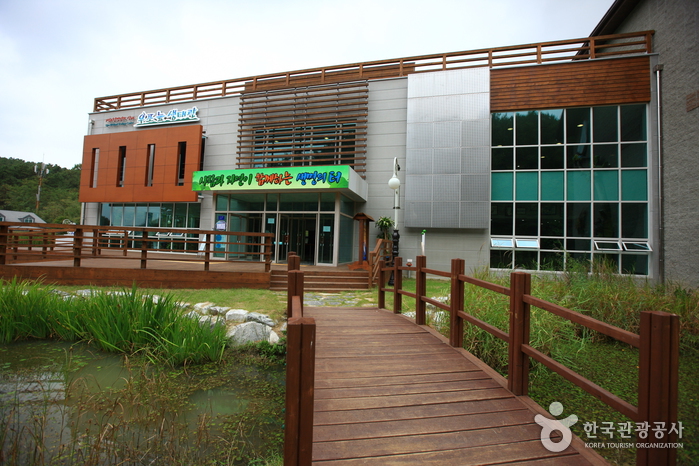Ilbungsa Temple (일붕사(의령))
0m 26801 2024-02-28
1180-42 Cheongjeong-ro, Gungnyu-myeon, Uiryeong-gun, Gyeongsangnam-do
Situated at the base of Bonghwangsan Mountain in Uiryeong, Ilbungsa Temple is renowned for being the world's largest cave temple, a distinction recognized by the Guinness World Records. It features two cave temples, including the Daeungjeon Hall Grotto and Muryangsujeon Grotto. A sought-after destination for those seeking the fulfillment of their wishes through prayer, Ilbungsa Temple is surrounded by other attractions including the Byeokgye Tourist Complex, Chalbigyegok Valley, and Bonghwangdae Cliff.
Byeokgyegyegok (Chalbi) Valley (벽계(찰비)계곡)
3.1 Km 14318 2021-02-20
201, Byeokgye-ro, Uiryeong-gun, Gyeongsangnam-do
+82-55-570-4958
Byeokgyegyegok Valley in Uiryeong, Gyeongnam region begins at Jagulsan Mountain and runs down along Hanusan Mountain, showcasing deep valleys and interesting rock formations. Also called Chalbigyegok Valley, the valley has clean water flowing all year round. The valley’s stream from the waterfall creates big and small ponds along its way, most famous among which are Gaksiso and Nongso ponds.
The biggest draw of this attraction is the crystal clear pond waters that are clean enough to reflect the surrounding forest like a natural mirror. Byeokgye Tourist Site and Byeokgye Reservoir located near the tail-end of the valley are growing into full-fledged tourist attractions for camping and fishing.
Suamsa Temple (수암사)
14.4 Km 0 2024-02-28
267 Suam-ro, Uiryeong-eup, Uiryeong-gun, Gyeongsangnam-do
Suamsa Temple is located on the slopes of Byeokhwasan Mountain in Uiryeong. The approach is a remarkable 650-meter path leading to the Cheonwangmun Gate, flanked by 333 outdoor statues of Avalokitesvara Bodhisattva crafted from jade stone — the largest collection of its kind in Asia. Beyond the Cheonwangmun Gate, the temple grounds unfold, revealing a series of halls. These include the Daejeokgwangjeon Hall with its Gilt-Bronze Ten-Thousand Buddhas, as well as the Geungnakjeon Hall, Gwaneumjeon Hall, and Buddhist Bell Pavilion.
Yeonhosa Temple (연호사)
15.2 Km 24433 2021-08-12
80, Jukjuk-gil, Hapcheon-gun, Gyeongsangnam-do
+82-55-931-2508
Yeonhosa Temple is located in Hapcheon-gun, Gyeongsangnam-do. With its back to Hwangusan Mountain, the temple faces the Hwanggang River. Designated as one of the Eight Great Views of Hapcheon, the temple is surrounded by mountains with a cliff on its back. The view of the gently flowing river from Hambyeongnu Pavilion is relaxing, even on rainy days when raindrops fall into the river.
Hambyeongnu Pavilion (함벽루)
15.2 Km 21754 2024-02-02
80 Jukjuk-gil, Hapcheon-gun, Gyeongsangnam-do
+82-55-930-3178
Included in Hapcheon's Eight Scenic Views, Hambyeongnu Pavilion was built in 1321, during the 8th year of Goryeo King Chungsuk by Hapcheon County Lord Kim. The location at the base of Daeyaseong Fortress, the pavilion offers views of Jeongyangho Lake on the Hwanggang River. The pavilion was visited by many poets, with writings from Toegye Yi Hwang, Nammyeong Josil, and Wooam Song Si-yeol hanging from tablets inside, and a rock engraved with "Hambyeongnu" in the handwriting of Song Si-yeol behind the pavilion.
Hambyeongnu is a 3-pillar wide by 2-pillar deep, 2-story pavilion, with an octagonal roof connected with a frame of five parts. The roof of the pavilion is famous in that when it rains, the water drips straight off the eaves and into the river below.
Hwanggyepokpo Falls (황계폭포)
17.1 Km 28899 2023-12-22
30 Hwanggye 2-gil, Hapcheon-gun, Gyeongsangnam-do
As a famous attraction that goes well with the charming surrounding scenery: the stream flowing from Gujangsan Mountain is beautiful and the surrounding rock cliffs spread out like a folding screen. In addition to the scenery, the sound of waterfall plunging down from a 20-meter-high cliff is like roaring thunder. The amount of water may vary, but it never runs out, making one forget the heat even in the middle of summer. The lowest tier of the waterfall pool is so deep, that legend has it that a dragon had once lived in the bottom of the pool. Ancient scholars were so fascinated by the beautiful scenery that they often compared it to the famous Yeosanpokpo Falls in China.
Agyang Ecology Park (악양생태공원)
17.6 Km 0 2023-10-11
208-49 Hagi 2-gil, Daesan-myeon, Haman-gun, Gyeongsangnam-do
Agyang Ecology Park is located along the Namgang River. The park is equipped with childrens play equipment, an outdoor stage, visitor's center and more. The park is a great location for people seeking to relax in nature, with many wild flowers and pink muhly growing along the pathways here.
Hapcheon Film Park (합천 영상테마파크)
19.5 Km 6000 2024-01-05
119 , Dongseo-ro, Hapcheon-gun, Gyeongsangnam-do
+82-55-930-3761
Hapcheon Film Park is filled with a unique atmosphere and things to see in every alley, and has been used as a filming location for over 190 dramas, movies, and music videos set in the 1920s to the 1980s. Visitors can look around using trams, wagons, and more while they take pictures of every place. Behind the theme park are the nation's best bonsai park and a garden theme park that span an area of 150,000 ㎡. In addition to the main Cheong Wa Dae filming set, there is a bonsai greenhouse, an ecological forest experience center, and a wood culture experience center that can be enjoyed by both adults and children.
* No cars are allowed to the Cheong Wa Dae filming set (as of September 1, 2019)
Upo Wetland Eco Center (우포늪생태관)
19.8 Km 12672 2021-08-23
220, Uponeup-gil, Changnyeong-gun, Gyeongsangnam-do
+82-2-1330
Upo Wetland Eco Center is a wetland education center at the largest wetland in Korea. The center collects data and conducts research on various wild wetland animals such as birds, fish, mammals, amphibians, and reptiles, and displays these to the public as well as promotes the message that humans are also part of nature and educates visitors on how humans can live in harmony with nature.
To help visitors learn more about the ecological environment, the center consists of various galleries: Understanding Upo Wetland, the Four Seasons of Upo Wetland, Living Upo Wetland, Families of Upo Wetland, and Understanding the Ecological Environment. Each gallery exhibits dynamic models and videos, as well as hands-on interactive programs.





 English
English
 한국어
한국어 日本語
日本語 中文(简体)
中文(简体) Deutsch
Deutsch Français
Français Español
Español Русский
Русский